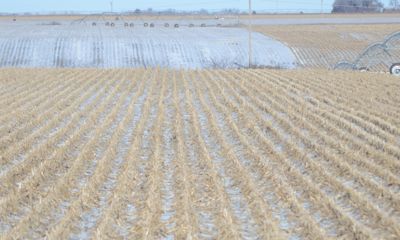
When it comes to reaching higher yields, uniformity in the field is an oft-cited rule of thumb. Many agronomists talk about maintaining uniformity in the field from planting through harvest. But how you manage soil and residue after harvest also affects uniformity – what Paul Jasa, University of Nebraska-Lincoln Extension engineer refers to as uniformity every day of the year.
"Uniformity every day of the year means everything in the field is uniform." Jasa says. "If you have non-uniformity in anything, it will cost you in yield."

YEAR-ROUND UNIFORMITY: Year-round uniformity starts with paring the tillage tools and leaving residue on the soil surface, says Paul Jasa. Standing residue at uniform height across a field makes for a uniform layer of snow – an insulating blanket to keep the soil warmer. With standing residue next spring, air movement to the soil surface and sunshine hitting the surface is uniform.
It starts with residue on the soil surface. "I like standing residue at uniform height across the field, standing residue for snow capture as I want a uniform layer of snow. It's an insulating blanket to keep the soil warmer, because the cold air doesn't touch the soil," Jasa says. "With residue standing next spring when things warm up, you get air exchange at the soil surface. If the residue is matted down, it stays cold and wet under that mat. With standing residue, the air movement to the soil surface and sunshine hitting the surface is uniform, so we didn't have variability in moisture or temperature in the soil surface."
Under long-term no-till with uniform residue, the soil structure is intact, and the soil profile dries out more uniformly over time, and will dry out earlier. Sure, strip tillage helps dry out the soil, and can make a nice transition from full-width tillage, but for long-term soil structure improvement, building organic matter, infiltration, and water-holding capacity, it takes parking the tillage tools, Jasa says.
But it takes some time for the biological activity to start working to break down residue. "The first year under no-till, you complain about too much residue because you've got no soil biological life. The longer you no-till, the less you're going to want to chop residue. On long-term no-till, you've got soil biological activity working," Jasa says. "Never cut residue loose – have it work for you and stay uniform."
~~~PAGE_BREAK_HERE~~~
With uniform residue under long-term no-till, Jasa encourages growers to plant down the old row, especially in a crop rotation. For corn-on-corn, he advises planting as close to the old row as possible.
"There aren't wheel tracks, and it's the least compacted part of the field. By planting into the old row, it's the most biologically active area of the field. The soil life is breaking down last year's roots and releasing nutrients to this year's roots," he says. "After a couple years of biology activity, the root balls will rot off from underneath, and I can plant down the old row. You'll have more residue over the row, but residue is your friend. It helps buffer the temperature and soil moisture while reducing runoff and crusting."
In order to build soil structure faster, it might take intensifying the cropping system, introducing a cover crop into the mix after harvesting corn or soybeans, introducing winter wheat into the rotation in order to establish cover crops earlier on in the year, or interseeding cover crops into standing corn or soybeans.
Of course, the first step is parking the tillage equipment. Although strip till might seem like a good transition into no-till, Jasa notes it brings non-uniformity. "When it comes to uniformity, I don't like strip till because you are fluffing and loosening a zone six to eight inches wide, but everything around it is firm. That's the least uniform root zone you'll have," Jasa says. "By parking the tillage tools we'll get more biology there. Meanwhile, living roots feed that biology."
About the Author(s)
You May Also Like






